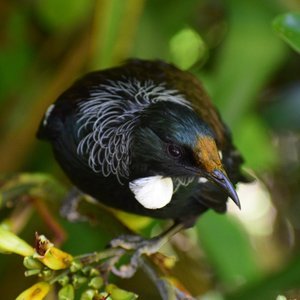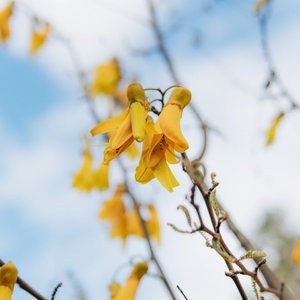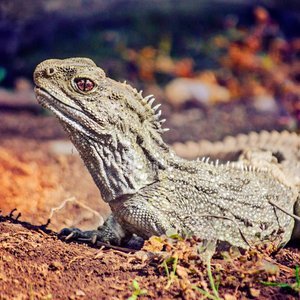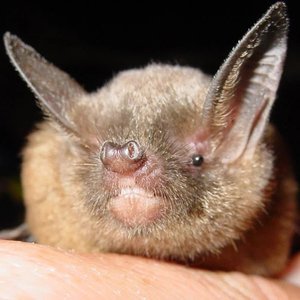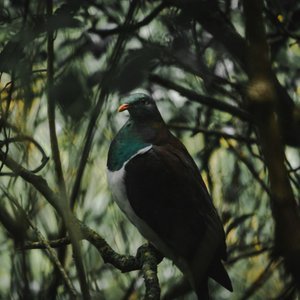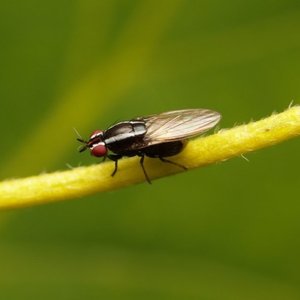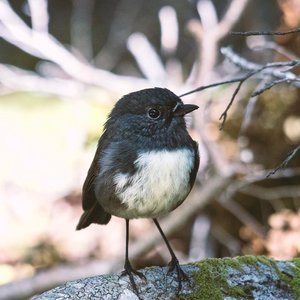Information-Sharing for the Public Good
Native Biodiversity of Aotearoa New Zealand - by Georgia Wells - created for the Eco-index to illustrate the diversity of ecosystem and species on land and in freshwater. © 2021 CC BY-NC-ND
As Aotearoa and Papatūānuku face an urgent and undeniable biodiversity crisis, EHF Fellow Nathaniel Calhoun (Cohort 1) is supporting transformative solutions that link biodiversity investment with measurable impact, and reward the preservation of biodiverse ecosystems with viable, commercial return. In his role as Strategy and Artificial Intelligence Advisor for New Zealand’s first certified Digital Public Good, Eco-index, Nathaniel helps guide a team that provides customised insights and recommendations for iwi, government, industry and communities to create better outcomes for our native species.
“There’s an emerging scientific consensus that if we can restore the original ecosystem coverage in an area to 15% of what it was before significant human interference and if we can connect that 15% to itself, then we can put a floor under biodiversity loss and enable natural systems to prevent further biodiversity decline,” Nathaniel says. “There’s no better idea of how to do that. We’re all gasping at the scale of biodiversity loss; the sheer quantity of species falling out of history weekly. But we now know we can put a floor under that loss, and the existence of that fact creates a moral obligation for all of us to get to that point.”
As one of the first international entrepreneurs to join the Edmund Hillary Fellowship (EHF), Nathaniel was more than ready to make the jump to Aotearoa when he arrived back in 2016. “We were among the first 10 people to apply and we had already begun to move our lives here. At the time, I worked mostly in international aid and development, largely with an African focus: in-hand financial empowerment, business literacy, training materials and mobile apps. Singularity University was the other major centre of gravity for me, as I was recruiting faculty and designing programmes with them. My time was effectively split between executive education and startups, and scaling open-source tech in emerging economies and low-income nations.”
That balance carried Nathaniel through his first few years in Aotearoa as he settled into the Far North, with its quietude offering a welcome contrast to the busy travel requirements of his work. “Then COVID smashed both of those careers. I thought I had built redundancy into my life by working with such different markets in Africa and in Silicon Valley, but I soon realised that the thing that connected them was they required people to gather together in small spaces.”
Nathaniel transitioned into distance consulting, primarily centred around his expertise in financial inclusion and blockchain technologies, but he also found himself with a front-row seat to some worrying land and water management decisions impacting the delicate and unique ecosystems and aquifer of the Far North. He reached out to the Department of Conservation to see where he could help with environmental monitoring and, after several discussions, was invited to help advise more than two dozen teams competing in the National Science Challenge’s BioHeritage. “One of the teams I was working with really understood the challenges of securing long-term, reliable adoption of their work. The conversations deepened and the team grew. Eventually, they seconded me away from the Bio-Heritage Challenge. That’s how I ended up in my current seat as Strategic Advisor for Eco-index.”
The Eco-index toolkit is designed to help anybody make long-term decisions around biodiversity management, investment and restoration priorities, Nathaniel says. The team is building algorithms to track changes in biodiversity levels and to correlate those changes with economic investments to show where money can be most effectively spent. “I have the highest regard for this team, their leadership, their strategy, the multidisciplinary nature of the work, their use of Te Ao Māori (Māori worldview) principles and their ecological and scientific rigour. I urged them to consider the Eco-index as a technology of international relevance that could be helpful for teams and countries around the world.” Indeed, the team has recently taken a huge step towards global impact with the certification of Eco-index as a Digital Public Good (DPG) in October of 2022.
As the first certified DPG in Aotearoa, Eco-index brings New Zealand to a global table of open-source creators and large-scale funders who are committed to changing the international power balance around technology and empowering low- and middle-income countries through the use of digital public initiatives. “The motivation for us was to avoid becoming an insular, inward-looking Kiwi tech innovation. There’s an opportunity here to put a flag in the ground and prioritise interoperability from the outset. It’s not about user capture or data capture, it’s about challenging yourself to build collaboratively with others.”
Joining the DPG Alliance enables Eco-index to work closely with other major providers in the biodiversity space, plugging in to amplify efforts, seeing the full landscape of the adjacent work being done and avoiding duplication. “By doing this, we’re also able to be a part of major risk-mitigation conversations to ensure that when we’re using AI to assess habitat and species loss, we’re training those algorithms correctly. It’s not hard to imagine the negative ramifications of scaling that technology globally without teaching it to look for the right things.”
There are major policy implications and opportunities presented by Aotearoa stepping onto the world stage with a noteworthy Digital Public Good, Nathaniel says. “Early next year, the [United Nations] Secretary General is aligning hundreds of millions of dollars to flow towards digital public infrastructure and DPGs. This has the potential to meaningfully address the hyper-fragmented, technological ecosystems that are stressful for policy-makers to navigate. I can see a future where the Ministry for the Environment (MFE), the Ministry for Climate Change, the Ministry of Primary Industries (MPI), the Ministry for Foreign Affairs and Trade and the Parliamentary Commission for the Environment all endorse the Digital Public Goods charter. This is a public statement of alignment to the idea that when the public sector invests in digital technology, it should do so openly and in non-duplicative ways. This ensures that public money has been spent as well as possible, isn’t captured by rent-seeking entities and has the greatest likelihood of favourable network effects with other governments, investments and research. It’s an absolute no-brainer from a policy point of view. And it’s still early enough that, if we can position our ministries and organisations in favour of this, we can join the first wave of significant international working groups that are just now creating the supportive ecosystem and the funding priorities for all DPGs.”
Nathaniel is already applying this thinking at a range of scales to create real-world biodiversity outcomes with a second Digital Public Good called Bioverse which is currently operating out of Brazil. “Where Eco-index operates on an ecosystem level, Bioverse is developing the capability to identify significant species from within rainforest canopies and is directly addressing species loss via productive conservation in the Amazon Rainforest. Economic interests in the region have often favoured destroying the rainforest for its timber and to make way for farming or mining. Against those pressures, the current carbon credit system is inadequate and inaccessible to many. What Bioverse does is help to shift economic incentives so that communities living in and around the forest see more economic potential in using and protecting the Amazon, than in selling it to be destroyed.”
In the near-term, this means creating a bio-economy which prioritises high-value crops like seed and nut trees, which can be wild-harvested to produce lucrative oils for value-added products like cosmetics. “Bioverse helps people know the potential of this bio-economy by using AI and drone technologies to pick the right places to succeed with the right species, and provide yield forecasts for land owners that give them income security. If you stand up a thriving bio-economy where everyone has visibility into their anticipated annual returns, they’ll be much less likely to sell off that land for destructive development.” Nathaniel expects to bring two more Amazon basin countries on board with Bioverse in 2023.
The most interesting challenge ahead for Eco-index, he says, is to find a consortia of sponsoring organisations. “I think there should be a few different Government agencies - like MFE and MPI - who recognise what we contribute and how it’s useful to what they do. We already have significant traction with industry, iwi and regional Councils. What we need now is a group of central Government organisations to join us and start looking for how they can endow and enduringly fund the work of Eco-index in a way that is not vulnerable to political change.”
The technology and the leadership are already well-established, Nathaniel says. “We don’t need any more small-scale testing. What we need now are godparents to start circling around us. We need patrons, people with big shoulders who can help keep us from falling between the cracks. We also need anyone with relevant data and high-quality satellite imagery to share it with us under some licence so our scientists can use it to better train our algorithms. If you have access to that data and you can use it to help us protect biodiversity, why wouldn’t you?”
At the root of both the biodiversity problem and the solution is a paradigm shift in how we think about information-sharing, Nathaniel says. “Deciding to build Digital Public Goods is a worthy strategy for suddenly belonging in many more of the discussions where decisions are being made about your industry and the funding that flows into it. I would seriously challenge the assumption that creators should be focused on copyrighting, trademarking and protecting their intellectual property to control its movement from one market to the next. The pace of technology now is so mind-blisteringly fast that the period when what you’re building is relevant is getting shorter all the time. The best way to make sure it reaches the most people while it is still relevant is to give it away, in accordance with best practices, from day one. Most of us aren’t going to build the next private, profitable company. Technological disruptions drive the failure rate of new businesses higher all the time. We need to abandon selfish pathways that prioritise owning the solution, or the narrative, and get better at giving our knowledge away from the beginning.”
To learn more, visit https://eco-index.nz/ and https://www.bioverse.io/ and connect with Nathaniel on LinkedIn.
Story by EHF Fellow Bex De Prospo (Cohort 2) and Director of Authentic Storytelling.


